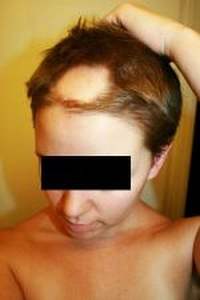

MedFriendly®


Alopecia Areata
A common disease (pictured below) of unknown cause
characterized by sudden well-defined, non-scarring bald patches
that are usually asymmetrical (uneven on all sides). The bald
areas are usually round or oval and located on the head but can
occur on any other hairy parts of the body such as the eyebrows
and bearded part of the face. The result is usually an
“exclamation point” type of look created by the hair at the end
that leaves an unclear scalp. The bald spots commonly enlarge
slowly. Fortunately, the condition usually resolves by itself with 6
to 12 months, so no treatment is involved. However, it is
common for the condition to occur again and can progress to
alopecia totalis, in which there is complete hair loss of the scalp.
This is most likely to occur when the condition occurs in
childhood.
FEATURED BOOK: Natural Hair Loss Secrets for Safe, Effective, Hair Growth
Alopecia areata is occasionally inherited from dominant autosomal genes in the parents.
Genes are units of material contained in a person's cells that contain coded instructions
as for how certain bodily characteristics (such as eye color) will develop. All of a
person's genes come from his/her parents. Genes can either be dominant or recessive.
A gene that masks the effect of another gene is called a dominant gene. The gene whose
expression is masked is known as a recessive gene. Genes are contained in structures
called chromosomes. Each person has 23 pairs of chromosomes, meaning that there are
46 chromosomes in total. One of each pair of chromosomes is inherited from the mother
and one of each pair is inherited from the father.
"Where Medical Information is Easy to Understand"™
The first 22 pairs of chromosomes (known as autosomes) are not
involved in determining sex. The 23rd pair of chromosomes,
however, is involved in determining sex. Thus, an autosomal gene is
a gene from one of the first 22 pairs of chromosomes.
There can also be an autoimmune cause for alopecia areata, which
is when the body’s immune system mistakenly attacks itself. This is
because the condition is known to be associated with other
autoimmune disorders and it is associated with the presence of
peribulbar lymphocytes when taking a biopsy (tissue sample) of the
scalp. A lymphocyte is a type of white blood cell which responds to
invading organisms in the body.

The term “peribulbar” refers to the appearance of these lymphocytes which looks like a swarm of bees
under the microscope. Alopecia areata comes for the Greek word “alopekia” which means “a disease
resembling fox mange” and the Latin word “areata” meaning “patch.” Put the words together and you have
“a disease resembling a fox mange patch.”














